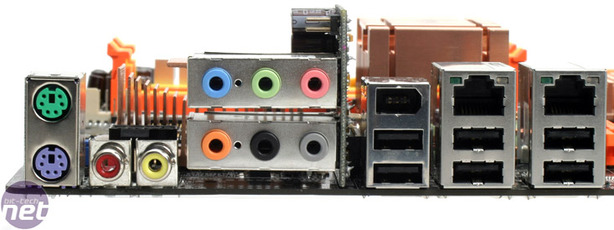The Rear I/O:
The Rear I/O panel is very typically DFI; with six USB 2.0 ports making you wish other companies copied this approach, since having ten supported on the southbridge leaves a healthy four to be routed elsewhere.Also included are the two Gigabit Ethernet RJ45 sockets, and a 6-pin Firewire plug above the USB ports. PS2 ports are still included for those who resist upgrading their keyboard and mouse, but there are no serial or parallel ports to speak of. Serial is provided through a motherboard pin out, but you'll have to provide your own adapter for it.
Finally there's coaxial S/PDIF in and out and the Karajan Audio module providing six 3.5mm audio jacks for 7.1 surround sound, as well as line in and microphone in. You can use S/PDIF without having to install the audio module, which is an advantage, but it's still subjected to having the data navigate through the motherboard which is open to potential crosstalk and shared grounding.
Whilst the Karajan audio module is a better implementation than other daughterboard alternatives, in that it takes less space, it's also a bit flimsier even with the additional plastic support (not shown below).

BIOS:
Frequency Adjustments:
Memory Frequency (Auto, Sync, DDR133-533 (translates to DDR2 266 to 1066)); CPU Frequency Adjustment (0-511MHz in 1MHz increments); Northbridge FSB Strap (Auto, 100-333 (translates to 400FSB to 1333FSB)); PCI-Express Overclocking (100 to 200MHz in 1MHz increments); Memory Overclocking (133 to 658MHz in 3MHz increments);Voltage Adjustments:
CPU Vid Control (0.44375V to 1.6000V); CPU VID Special Add (100.25% up to 121.5%); DDR2 Ram Voltage (1.8V to 3.01V); CPU VTT 1.2V (1.21V to 1.59V); NB Core 1.2V (1.30V to 2.18V); NB PLL 1.8V (1.83V to 2.51V); NB PLL 1.2V (1.21V to 1.46V); NB PCIE 1.2V (1.22V to 1.6V); NB core 1.2V convert from (1.81V to 2.39V); SB core voltage (1.23V to 1.59V); Clockgen voltage (2.92V or 3.40V); GTL REF Voltage control; CPU Core 1/2 GTL REF Volt; North Bridge GTL REF Volt;Memory Timings:
Burst Length; Command Rate; Address Command Drive Strength; Clocking Drive Strength; CAS Timing (tCAS); Read RAS to CAS Delay (tRCDR); Write RAS to CAS Delay (tRCDW); RAS Precharge (tRP); RAS Cycle Time (tRAS); Row Cycle Time (tRC); Refresh to Active (tRFC); Bank to Bank Command (tTRRD); Write Recovery (tRTW); Write to Write CS (tWTW_CS); Write to Read Command (tWTR); Write to Read CS (tWTR_CS); Read to Read CS (tRTR_CS); Read Data Transfer; Read Data Transfer; Read Strobe Delay; Read Strobe Arrival.Other Features:
CPU PLL override, Conroe P state Multiplier; PCIE GFX Lane Reversal (doesn't swap round the two PCI-Express x16 graphics slots, instead it swaps around the internal PCI lane layout); Memory Channel selection; Channel Mapping; Bank Mapping; More Miscellaneous Mapping; Memory Power Management; FSB I/O Drive Strength.
MSI MPG Velox 100R Chassis Review
October 14 2021 | 15:04










Want to comment? Please log in.